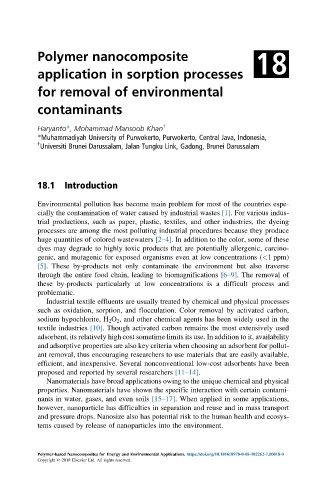Page 538 - Polymer-based Nanocomposites for Energy and Environmental Applications
P. 538
Polymer nanocomposite 18
application in sorption processes
for removal of environmental
contaminants
Haryanto*, Mohammad Mansoob Khan †
*Muhammadiyah University of Purwokerto, Purwokerto, Central Java, Indonesia,
†
Universiti Brunei Darussalam, Jalan Tungku Link, Gadong, Brunei Darussalam
18.1 Introduction
Environmental pollution has become main problem for most of the countries espe-
cially the contamination of water caused by industrial wastes [1]. For various indus-
trial productions, such as paper, plastic, textiles, and other industries, the dyeing
processes are among the most polluting industrial procedures because they produce
huge quantities of colored wastewaters [2–4]. In addition to the color, some of these
dyes may degrade to highly toxic products that are potentially allergenic, carcino-
genic, and mutagenic for exposed organisms even at low concentrations (<1 ppm)
[5]. These by-products not only contaminate the environment but also traverse
through the entire food chain, leading to biomagnifications [6–9]. The removal of
these by-products particularly at low concentrations is a difficult process and
problematic.
Industrial textile effluents are usually treated by chemical and physical processes
such as oxidation, sorption, and flocculation. Color removal by activated carbon,
sodium hypochlorite, H 2 O 2 , and other chemical agents has been widely used in the
textile industries [10]. Though activated carbon remains the most extensively used
adsorbent, its relatively high cost sometime limits its use. In addition to it, availability
and adsorptive properties are also key criteria when choosing an adsorbent for pollut-
ant removal, thus encouraging researchers to use materials that are easily available,
efficient, and inexpensive. Several nonconventional low-cost adsorbents have been
proposed and reported by several researchers [11–14].
Nanomaterials have broad applications owing to the unique chemical and physical
properties. Nanomaterials have shown the specific interaction with certain contami-
nants in water, gases, and even soils [15–17]. When applied in some applications,
however, nanoparticle has difficulties in separation and reuse and in mass transport
and pressure drops. Nanosize also has potential risk to the human health and ecosys-
tems caused by release of nanoparticles into the environment.
Polymer-based Nanocomposites for Energy and Environmental Applications. https://doi.org/10.1016/B978-0-08-102262-7.00018-0
Copyright © 2018 Elsevier Ltd. All rights reserved.

